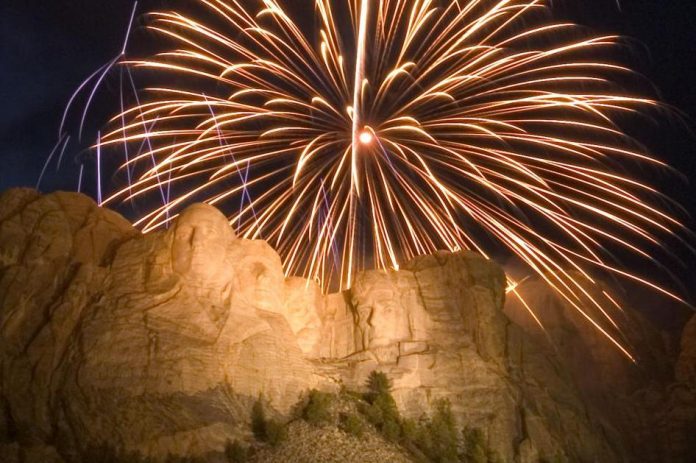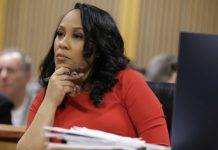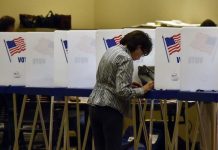
March 9 (UPI) — Mount Rushmore National Memorial in South Dakota will light up with fireworks for the first time in a decade if the National Park Service approves a fast-tracked plan.
The state’s Republican Gov. Kristi Noem and President Donald Trump asked U.S. Interior Secretary David Bernhardt in May to help bring back fireworks to the park, which lies in the middle of the Black Hills National Forest.
A tradition of fireworks displays at the monument ended in 2009 after foresters said there was too much of a fire risk in the area because of dead ponderosa pine trees that had been killed by pine beetles.
The parks agency began work on a draft environmental analysis after the state and Department of Interior issued a memorandum of agreement to “exercise their full authorities” to return fireworks to Mount Rushmore National Memorial “in a safe and responsible manner.”
The federal agency is seeking public comment through March 30 on an environmental analysis released in late February. It also will hold three local meetings in towns near the monument.
“Public engagement will play a key role in the planning process for the National Park Service,” David Vela, deputy director for the memorial site, said in a statement.
The current plan proposed by the park service is to stage a 15- to 30-minute professional fireworks display July 3.
The park always has celebrated on July 3, said Maureen McGee-Ballinger, the park’s chief of interpretation and education. “We want visitors to be able to visit other celebrations in the Black Hills on July 4 if they wish to,” she said.
The park has formerly hosted Independence Day picnics, music and historic reenactments during the day, and those will continue.
The new environmental analysis released by the park shows some of the challenges that fireworks have presented in the past. The report does not make a recommendation about whether fireworks should return.
More than 20 accidental fires were started by fireworks displays between 1998 and 2009, excluding 2002, when the event was cancelled because of extremely dry conditions, the report said.
Also, shooting fireworks off the top of the monument left black ash scars on the sculptured heads of U.S. presidents George Washington, Thomas Jefferson, Abraham Lincoln and Theodore Roosevelt.
“The burn marks are still there from previous fireworks events,” spokeswoman McGee-Ballinger said.
Also, according to the report, concentrations of perchlorate, a chemical used in fireworks, lingered in drinking water reservoirs near the monument as late as 2015, years after the fireworks had been cancelled in the park.
The Park Service does not have adequate power for a laser light show because the memorial is at the end of a power grid line, the report said. Power fluctuations dimmed a 2002 laser show.
Several local tribal leaders have opposed the revival of fireworks at Mount Rushmore. The monument and surrounding Black Hills are located in tribally disputed territory based on treaties in the 1860s. The U.S. Supreme Court ruled in 1980 that the region was unfairly taken from the Sioux tribe without compensation.
“We would like to assert for the record, and in the strongest terms, that we object to the reintroduction of the fireworks at Mount Rushmore,” said a letter to the park service from Robert Flying Hawk, chairman of the Yankton Sioux Tribe.
“[T]o discharge fireworks within or around our sacred sites would be tantamount to sacrilege and would egregiously violate our cultural and spiritual protocols.”
The park does not allow open flames at tribal religious ceremonies, such as sweat lodge purifications, during the summer, another tribal leader said.
“When tribes partake in ceremonies in the Black Hills, they’re told they can’t light a fire because of the fire threat level during that time of year,” Julian Bear Runner, president of the Oglala Sioux on the Pine Ridge Reservation, told UPI.
Far greater danger could result from a fireworks show than a Native American ritual, Bear Runner said.
“I’m not a fire expert, but I do have common sense. At that time of year, it’s very dry and hot. They have no control over these fireworks. They could be duds, they could malfunction, they’re not guaranteed to be safe,” Bear Runner said.
The park service will develop a “go/no-go” checklist that will allow the fireworks to be canceled if weather does not cooperate or fire danger is too high, the report said. Details of that list are not available, the park’s spokeswoman said.
South Dakota Gov. Noem has made the fireworks a priority and hopes to return the spectacle to its former glory, she said. The state would be in charge of hiring the fireworks vendor.
“When the fireworks were previously held at Mount Rushmore, the show was beamed around the globe via satellite,” Noem said in a statement. “The entire world was able to view a celebration of our nation’s freedoms from the majestic memorial and the beautiful Black Hills of South Dakota.
“There is no more fitting place in all the nation to celebrate our democracy than from Mount Rushmore.”
Trump even hinted he would show up.
“I called up our people, and in 15 minutes got it approved. And we will have our first big fireworks display at Mount Rushmore, and I will try and get out there if I can,” Trump said in January during an event marking an initial trade pact with China.
“If President Trump shows up at the park on July 3, I’m sure we’ll know about it,” spokeswoman McGee-Ballinger said.






